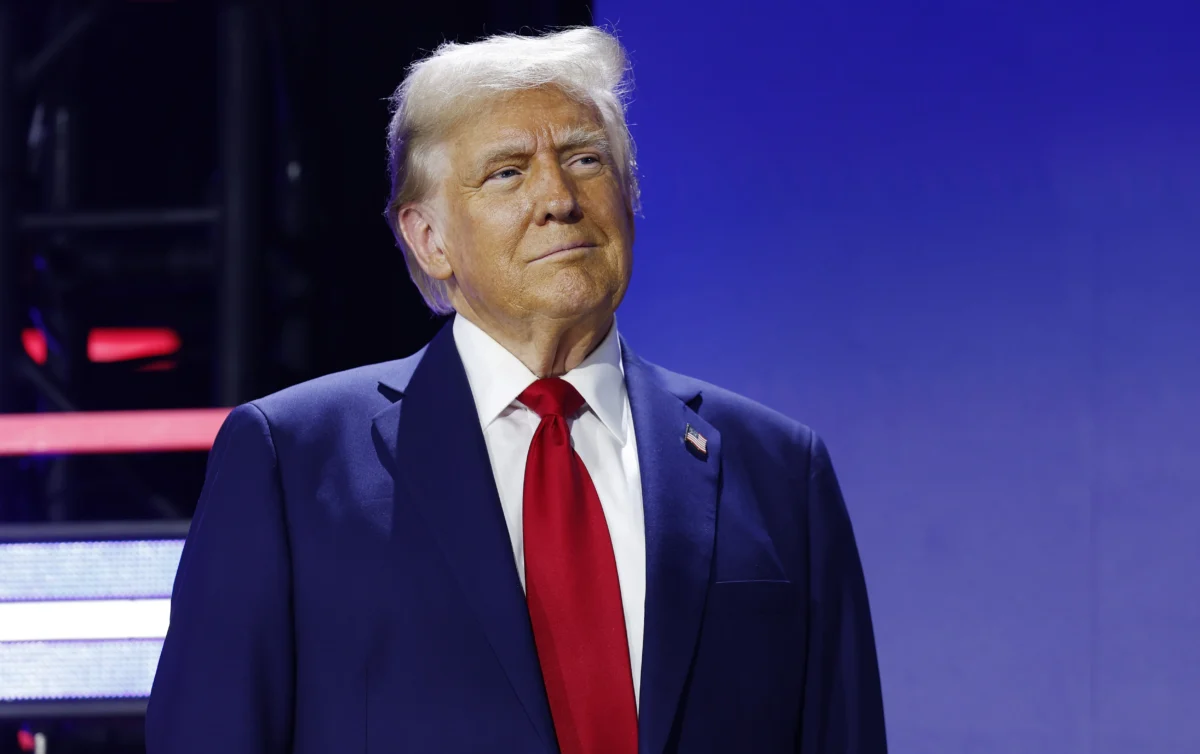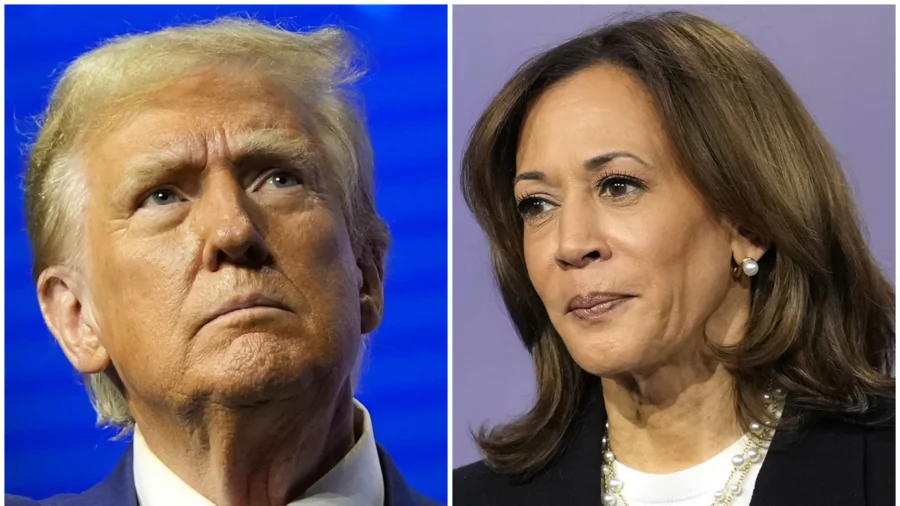Voters in this year’s presidential election are choosing between two conflicting visions of the United States offered by Democrat Kamala Harris and Republican Donald Trump.
Since replacing President Joe Biden as the Democratic nominee, Harris has pledged to blaze her own path forward. But many of the vice president’s ideas are well trod by Biden: middle-class tax cuts, tax increases on the wealthy and corporations, guaranteeing abortion access, and a government that aggressively addresses climate change.
Former President Trump wants to undertake a mass deportation of migrants who are living in the United States illegally, extend and expand his 2017 tax cuts, greatly increase tariffs and offer more support for fossil fuels and less support for renewable energy. He has pledged to end Russia’s war with Ukraine while suggesting Ukraine must make territorial concessions. He also is seeking to concentrate more government power within the White House.
The candidates have spelled out their ideas in speeches, advertisements, and other venues. Both say that their approach would do more to lift up workers, the middle class and the promises that have defined America. While Trump and Harris agree on not taxing workers’ tips, the similarities largely stop there—a further sign of how the election’s outcome could reshape the country.
A look at where each candidate stands on some key issues:
Abortion
HARRIS: She has called on Congress to pass legislation guaranteeing abortion access in federal law.
Harris has promoted the administration’s efforts short of federal law, including steps to protect women who travel to access the procedure and limit how law enforcement collects medical records.
TRUMP: Trump announced last spring that decisions on access and cutoffs should be left to the states. He has praised the patchwork of restrictions that have emerged across Republican-led states, saying the people are deciding.
He has said he would not sign a national abortion ban into law and would not try to block access to abortion medication. He told Time magazine that it should also be left up to states to determine whether to prosecute women for abortions or to monitor their pregnancies. He has said that, if he wins, he wants to make in vitro fertilization treatment free for women.

Climate and Energy
HARRIS: She has done something of an about-face, saying in her campaign that it’s possible to continue hydraulic fracturing for fossil fuels even as she embraces policies that favor renewable energy resources. Republicans are quick to point out that Harris opposed offshore drilling and fracking during her short-lived campaign for the 2020 presidential nomination.
As a senator from California, Harris was an early sponsor of the Green New Deal, a sweeping series of proposals meant to swiftly move the United States to fully green energy. It was a plan championed by the Democratic Party’s most progressive wing. But during her tenure as vice president, Harris has adopted more moderate positions, focusing on implementing the climate provisions of the Biden administration’s Inflation Reduction Act. That provided nearly $375 billion for things such as financial incentives for electric cars and clean energy projects.
The Biden administration has also enlisted more than 20,000 young people in a national Climate Corps, a Peace Corps-like program to promote conservation through projects such as weatherizing homes and repairing wetlands. Despite that, it’s unlikely that the United States will be on track to meet Biden’s goal of cutting greenhouse gas emissions in half by 2030.
TRUMP: His mantra for one of his top policy priorities: “DRILL, BABY, DRILL.” Trump, who in the past said climate change was a “hoax,” says it’s his goal for the United States to have the cheapest energy and electricity in the world. He has said he will cut prices in half within a year of his potential return to office.
Trump wants to push domestic oil production higher by increasing oil drilling on public lands, offering tax breaks to oil, gas and coal producers, speeding the approval of natural gas pipelines, opening dozens of new power plants, including nuclear facilities, and rolling back the Biden administration’s aggressive efforts to get people to switch to electric cars, which he argues have a place but shouldn’t be forced on consumers. He has also pledged to re-exit the Paris climate agreement, end wind subsidies and eliminate regulations imposed and proposed by the Biden administration targeting lightbulbs, stoves, dishwashers, and shower heads.

Immigration
HARRIS: Harris has said she would sign into law a bipartisan Senate compromise killed by Republican lawmakers. She said the bill would have toughened asylum standards and meant more border agents, immigration judges and asylum officers. She said she would bring back that bill and sign it, saying that Trump “talks the talk, but doesn’t walk the walk” on immigration.
Proponents of the bill said it would grant Biden additional authority to close the border and that it would alleviate the situation by providing new funding that could help stop the flow of fentanyl over the border. Opponents contend that the bill doesn’t secure the border and might only make the situation worse—particularly through a clause that could effectively codify allowing 5,000 illegal aliens into the country per day.
Harris likes to talk up her experience as California attorney general, saying she walked drug smuggler tunnels and successfully prosecuted gangs that moved narcotics and people across the U.S.–Mexico border. Early in his term, Biden made Harris his administration’s point person on the root causes of migration. Trump and top Republicans blame Harris for a situation at that border, which they say is out of control due to policies that were too lenient. Harris has endorsed a comprehensive immigration overhaul, seeking paths to citizenship for immigrants in the United States without legal status, with a faster track for young immigrants living in the country illegally who arrived as children.
TRUMP: He promises to mount the largest domestic deportation in U.S. history. He would bring back policies he put in place during his first term, like the Remain in Mexico program and Title 42, which placed curbs on illegal immigrants on public health grounds. He has called for the death penalty for any illegal immigrant who kills a U.S. citizen.
Trump would revive and expand the travel ban that originally targeted citizens from seven countries deemed a threat to the United States. After the Oct. 7, 2023, attack by Hamas terrorists on Israel, Trump pledged new screening for immigrants to bar “dangerous lunatics, haters, bigots, and maniacs.” He would try to deport people who are in the United States legally but harbor “jihadist sympathies.” He would seek to end birthright citizenship for people born in the United States whose parents are both in the country illegally.

Israel and Gaza
HARRIS: Harris says Israel has a right to defend itself, and she’s repeatedly decried Hamas as a terrorist organization. But the vice president might have helped defuse some backlash from progressives by being more vocal about the need to better protect civilians during fighting in Gaza.
More than 42,000 Palestinians have been killed in the war in Gaza, according to the Health Ministry in the Hamas-ruled territory. The ministry does not distinguish between civilians and terrorists in its count. Israel says it has killed more than 17,000 terrorists in the war.
Like Biden, Harris supports a proposed hostage-for-extended cease-fire deal that aims to bring all remaining hostages and Israeli dead home. Biden and Harris say the deal could lead to a permanent end to the war and they have endorsed a two-state solution, which would have Israel existing alongside an independent Palestinian state. But Biden is also confronting the prospect of a widening conflict in Lebanon and attacks by Iran even as they both see Israel’s recent killing of Hamas leader Yahya Sinwar as a reason for a cease-fire to be more likely.
TRUMP: He has expressed support for Israel’s efforts to “destroy” Hamas, but he’s also been critical of some of Israel’s tactics. He says the country must finish the job quickly and get back to peace. He has called for more aggressive responses to pro-Palestinian protests at college campuses and applauded police efforts to clear encampments. Trump also proposes to revoke the student visas of those who espouse antisemitic or anti-American views and deport those who support Hamas.
NATO and Ukraine
HARRIS: The vice president has yet to specify how her positions on Russia’s war with Ukraine might differ from Biden’s, other than to praise his efforts to rebuild alliances unraveled by Trump, particularly NATO, the military alliance that is a critical bulwark against Russian aggression.
The Biden administration has pledged unceasing support for Ukraine against Russia’s invasion. Washington has sent tens of billions of dollars in military and other aid to Ukraine, including $61 billion in weapons, ammunition and other assistance that is expected to last through the end of this year. The government has also reached an agreement with allies to provide Ukraine with a $50 billion loan—with $20 billion from the United States—that would be backed by frozen Russian financial assets.
The administration has maintained that continuing U.S. assistance is critical because Russian leader Vladimir Putin will not stop at invading Ukraine. Harris has said previously that it would be foolish to risk global alliances the United States has established and decried Putin’s “brutality.”
TRUMP: The former president has repeatedly taken issue with U.S. aid to Ukraine and says he will continue to “fundamentally reevaluate” the mission and purpose of the NATO alliance if he returns to office. He said he will be able to end the war before his inauguration by bringing both sides to the negotiating table.
On NATO, he has criticized member nations for years for failing to meet agreed-upon military spending targets. He had warned leaders that he would refuse to defend nations that don’t hit those targets.

Tariffs and Trade
HARRIS: The Biden-Harris administration has tried to boost trade with allies in Europe, Asia and North America, while using tariffs and other targeted tools to go after rivals such as China. The Democratic administration kept Trump’s tariffs on China in place, while adding a ban on exporting advanced computer chips to that country and providing incentives to boost U.S. industries.
In May, the administration specifically targeted China with increased tariffs on electric vehicles and steel and aluminum, among other products.
TRUMP: He wants a dramatic expansion of tariffs on nearly all imported foreign goods, saying that “we’re going to have 10 percent to 20 percent tariffs on foreign countries that have been ripping us off for years.” He has suggested tariffs of 100 percent or more on Chinese goods. He treats these taxes as a way to fund other tax cuts, lower the deficit and possibly fund child car.
Trump would urge Congress to pass legislation giving the president authority to impose a reciprocal tariff on any country that imposes one on the United States. Much of his trade agenda has focused on China. Trump has proposed phasing out Chinese imports of essential goods including electronics, steel and pharmaceuticals and wants to ban Chinese companies from owning U.S. infrastructure in sectors such as energy, technology and farmland.
Taxes
HARRIS: With much of the 2017 tax overhaul expiring at end of next year, Harris is pledging tax cuts for more than 100 million working and middle class households. In addition to preserving some of the expiring cuts, she wants to make permanent a tax credit of as much as $3,600 per child and offer a special $6,000 tax credit for new parents.
Harris says her administration would expand tax credits for first-time homebuyers and would push to build 3 million new housing units in four years, while wiping out taxes on tips and endorsing tax breaks for entrepreneurs. Like Biden, she wants to raise the corporate tax rate to 28 percent and the corporate minimum tax to 21 percent. The current corporate rate is 21 percent and the corporate minimum, raised under the Inflation Reduction Act, is at 15 percent for companies making more than $1 billion a year. But Harris would not increase the capital gains tax as much as Biden had proposed on investors with more than $1 million in income.
TRUMP: Trump has promised a slew of new tax cuts aimed at groups he has been trying to win over this election, including eliminating taxes on tips received by workers—a policy later embraced by Harris, who would also raise the minimum wage for tipped workers. Trump wants to eliminate taxes on Social Security benefits and taxes on overtime pay, and has pledged to make interest on car loans tax-deductible like mortgage payments—but only for cars built in the United States.
The former president has promised to extend and even expand all of the 2017 tax cuts that he signed into law, while also paying down the debt. He has proposed cutting the overall corporate tax rate to 15 percent from 21 percent, but only for companies that make their products in the United States. He would repeal any tax increases signed into law by Biden. He also aims to gut some of the tax breaks that Biden put into law to encourage the development of renewable energy and EVs.
He wants to lower the cost of housing by opening up federal land to development.
The Associated Press contributed to this report.

